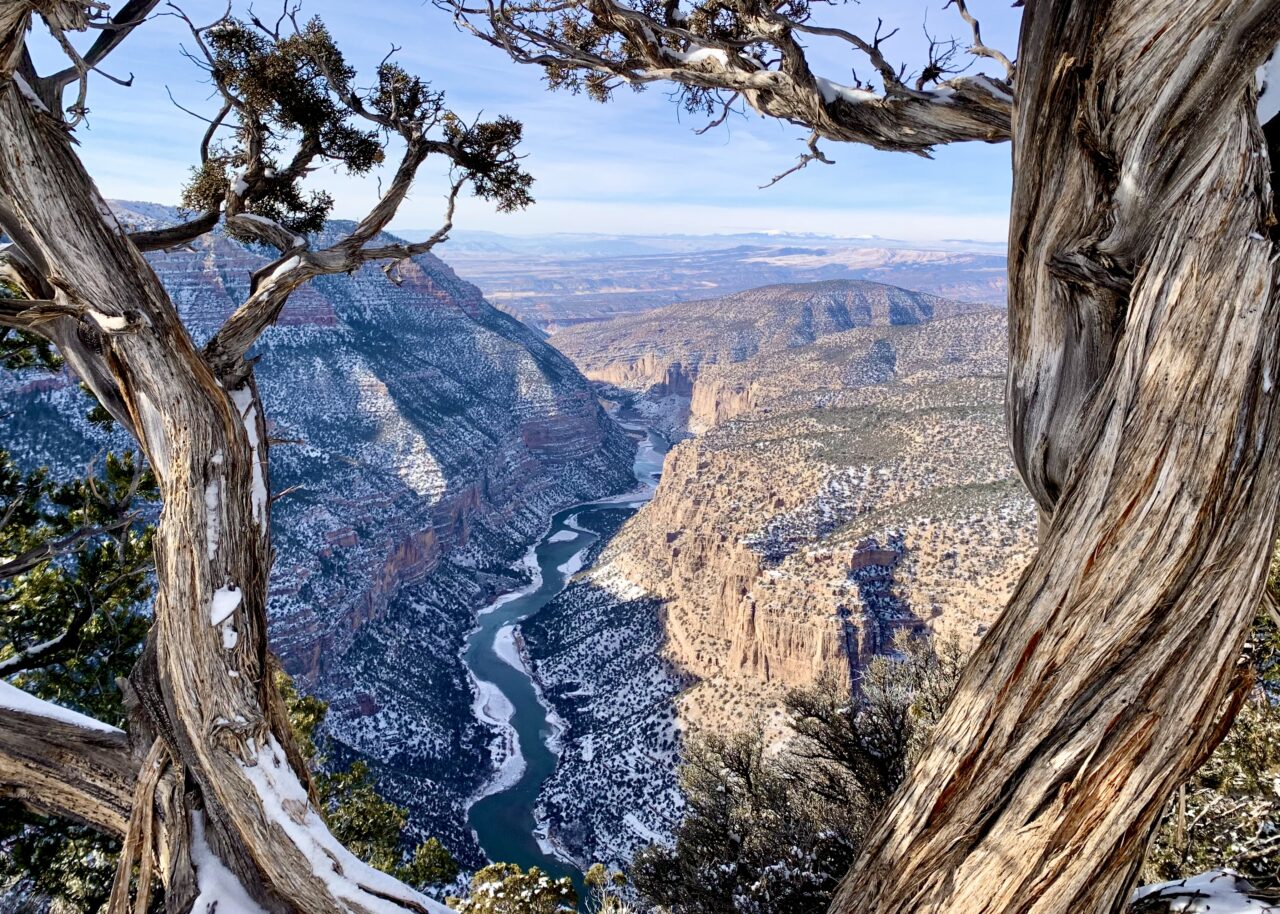Get more Southwest News & Travel Tips Here
Where is Dinosaur National Monument located?
Dinosaur National Monument is located in the northwestern corner of Colorado and the northeastern section of Utah, straddling the border of the two states. The closest towns to this natural wonder are Vernal, Utah, and Craig, Colorado. Vernal is known for its rich Western heritage and serves as a gateway to the monument, featuring amenities and local attractions. Craig, situated a bit further to the east, offers a glimpse into the rural life of Colorado, with stunning landscapes and outdoor activities to enjoy.
Get more Dinosaur National Monument Travel Tips & News here!
Best Time to Visit Dinosaur National Monument
The best time to visit Dinosaur National Monument is during the spring and fall seasons, specifically from late April to early June and from September to October. During these months, visitors can expect mild weather, ideal for hiking and exploring. Summer can be hot, with temperatures often exceeding 90°F (32°C), leading to large crowds, especially during school vacation periods. Winter, while quiet and serene, can bring snow and icy conditions, which may limit accessibility to some areas of the park.
How to get to Dinosaur National Monument?
For those traveling by air, the nearest regional airport is Vernal Regional Airport (VEL), located about 30 miles from the park. This small airport mainly serves domestic flights. For international travelers, the closest major airport is Salt Lake City International Airport (SLC), approximately 180 miles away. Car rentals are readily available at both airports, providing easy access to Dinosaur National Monument.
What to do when you arrive:
Upon arrival, the first stop should be the Dinosaur National Monument Visitor Center, located in Jensen, Utah. Here, visitors can find valuable information, park maps, and educational exhibits about the area’s rich paleontological history. For accommodations, options range from campgrounds within the park to nearby hotels in Vernal or Craig. Camping enthusiasts can enjoy the scenic sites, while those seeking comfort can find cozy lodgings in town.
Getting Around Locally
Getting around Dinosaur National Monument is best done by car, as public transportation options are limited. The roads within the park are well-maintained, allowing visitors to easily access various attractions and trailheads. Visitors can also explore the park via designated hiking and biking trails, providing a more immersive experience in nature.
Top Things to Do and See at Dinosaur National Monument:
- Carnegie Quarry:The heart of Dinosaur National Monument, Carnegie Quarry is famous for its remarkably preserved dinosaur fossils embedded in the rock face. Visitors can observe fossil displays and learn about paleontology through informative exhibits.
- Green River:The Green River runs through the monument, offering opportunities for rafting, canoeing, and kayaking. Adventurers can explore the scenic canyons and enjoy the diverse wildlife along the riverbanks.
- Echo Park:This picturesque area features breathtaking views, lush greenery, and the convergence of the Yampa and Green Rivers. Echo Park is perfect for picnicking, hiking, and photography, with trails leading to stunning overlooks.
- Hiking Trails:Dinosaur National Monument boasts several hiking trails of varying difficulty. Popular options include the Fossil Discovery Trail, which offers a chance to see fossils in situ, and the Sound of Silence Trail, known for its serene landscapes and solitude.
- Historic Ranches:Explore the history of the area by visiting the historic homesteader ranches within the monument. These sites provide insight into the lives of early settlers and ranchers, showcasing the rich cultural heritage of the region.
Suggested Itineraries
For a short visit, a 2-day itinerary could include:
- Day 1: Visit the Carnegie Quarry and spend the afternoon exploring the visitor center. Hike the Fossil Discovery Trail.
- Day 2: Raft the Green River in the morning, followed by a picnic at Echo Park, and end the day with a scenic drive through the monument.
For a longer stay, consider adding a day for hiking in the backcountry or exploring more remote areas of the park.
Permits & Fees
Entrance to Dinosaur National Monument requires a fee, with options for a vehicle pass, individual pass, or annual pass. Camping fees apply for those wishing to stay in designated campgrounds. For specific permit requirements, such as for river rafting, check the official National Park Service website.
Nearby Day Trips & Detours
Visitors can also explore nearby attractions, such as:
- Flaming Gorge National Recreation Area: Known for its stunning blue waters and dramatic cliffs, this area offers hiking, fishing, and boating opportunities.
- Vernal, Utah: A charming town with museums, local shops, and dining options, perfect for a day of exploration.
- Steamboat Springs: About a two-hour drive from the monument, this resort town features hot springs, skiing in winter, and hiking trails in summer.
Local Culture & History
Dinosaur National Monument is rich in cultural history, having been home to Native American tribes such as the Ute. The area was later explored by early settlers, and its fossil-rich landscape has drawn paleontologists for decades. The monument serves not only as a natural wonder but also as a testament to the region’s vibrant history and cultural significance.
Where to Stay in Dinosaur National Monument
When planning your visit to Dinosaur National Monument, choosing the right accommodation can enhance your experience. Here’s a list of options to suit various preferences and budgets:
- Hotels:
- Best Western Dinosaur Inn in Vernal offers comfortable rooms and convenient amenities like free breakfast and a pool.
- Quality Inn in Vernal is another great option, with proximity to local attractions and restaurants.
- Motels:
- Super 8 by Wyndham provides affordable lodging with basic amenities, ideal for budget travelers.
- River Valley Inn is known for its friendly service and clean rooms, making it a popular choice among visitors.
- Campgrounds:
- Green River Campground offers a scenic riverside experience with amenities like picnic tables and fire pits.
- Canyon Campground is another great option, featuring beautiful canyon views and access to hiking trails.
- Glamping:
- Under Canvas offers luxury tents near Dinosaur National Monument, combining the beauty of nature with comfort.
- Airbnb & VRBO:
- Check local listings for unique stays in the surrounding area, including cozy cabins and homes with kitchen facilities.
- KOA:
- The Vernal KOA offers tent and RV sites, as well as deluxe cabins, along with family-friendly amenities.
Dining Options
There’s a variety of dining options available near Dinosaur National Monument, catering to different tastes and budgets:
- Grab and Go:
- Subway in Vernal offers quick sandwiches and salads for those on the move.
- McDonald’s provides familiar fast food options for a quick meal.
- Family-Friendly:
- Fuzzy’s Taco Shop serves up casual Mexican fare, including tacos and burritos, perfect for families.
- El Rancho Restaurant offers traditional Southwestern cuisine in a family-friendly setting.
- Upscale Dining:
- Western Park in Vernal features a more refined menu with local ingredients and a cozy atmosphere.
- In-Park Dining:
- While there are limited dining options within the park, consider packing a picnic to enjoy at scenic spots like Echo Park.
Packing List & What to Bring
To ensure a comfortable and enjoyable visit to Dinosaur National Monument, consider bringing the following items:
- Comfortable hiking shoes or boots
- Weather-appropriate clothing (layers for changing conditions)
- Sun protection: sunscreen, sunglasses, and a wide-brimmed hat
- Reusable water bottle (stay hydrated on hikes)
- Snacks or a picnic lunch for outdoor meals
- Binoculars for wildlife viewing
- Camera for capturing stunning landscapes and fossils
- First aid kit for minor injuries
- Map of the park (though GPS is helpful, having a physical map is a great backup)
Wildlife & Nature Highlights
Dinosaur National Monument is home to diverse wildlife and breathtaking natural features. Visitors can expect to see:
- Mammals: Mule deer, coyotes, and bobcats can often be spotted in the park.
- Birds: Birdwatchers can delight in spotting species like golden eagles, red-tailed hawks, and various songbirds.
- Reptiles: Look out for lizards and snakes, which are common in the warmer months.
- Flora: The park showcases a variety of ecosystems, from sagebrush deserts to lush riparian zones along the river.
Accessibility Information
Dinosaur National Monument strives to be accessible for all visitors. Key accessibility features include:
- The Visitor Center is wheelchair accessible and includes accessible restrooms.
- Some hiking trails, such as the Fossil Discovery Trail, are designed to accommodate visitors with mobility challenges.
- Accessible parking is available at key locations throughout the park.
FAQs
Here are some frequently asked questions regarding your visit to Dinosaur National Monument:
- Do I need a reservation for camping? Yes, especially during peak seasons, it’s recommended to book your campsite in advance.
- Are pets allowed in the park? Pets are allowed in certain areas of the park but must be on a leash and cleaned up after.
- What should I do if I encounter wildlife? Keep a safe distance, do not feed them, and ensure your safety by staying calm.
Conclusion & Additional Resources
Dinosaur National Monument offers a unique blend of natural beauty, outdoor adventure, and rich history. Whether you’re hiking along the trails, rafting the Green River, or marveling at ancient fossils, there’s something for everyone to enjoy. For more information, tips, and resources for planning your trip, visit the official National Park Service website or check out local tourism sites.
Follow us on Facebook for updates and community tips: National Park Adventurers.


